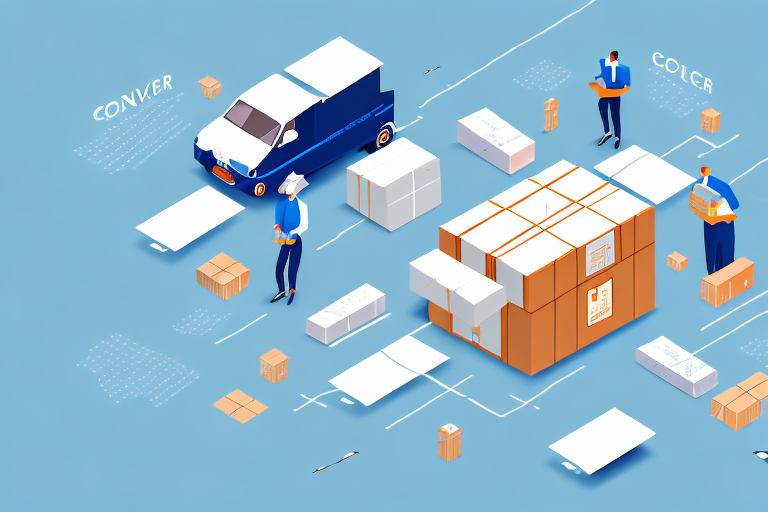As a business owner, one of the most critical aspects of success is ensuring the timely and efficient delivery of your products to your customers. Whether you're shipping products to local customers or selling internationally, the delivery process can be complex, with many factors to consider, such as speed, cost, reliability, and more. In this article, we'll explore various options for arranging delivery for your business and provide tips for streamlining the process, optimizing costs, and improving customer satisfaction.
The Importance of Efficient Delivery for Business Success
In today's fast-paced business world, customers expect quick and reliable delivery of their purchases. According to a Statista survey, 63% of consumers consider fast shipping as a crucial factor in their purchasing decisions. A slow or inefficient delivery service can lead to frustration, negative online reviews, and lost customers. Conversely, offering fast and reliable delivery can help build your brand reputation, increase sales, and foster customer loyalty.
Efficient delivery not only benefits the customer but also the business. By optimizing delivery routes and reducing delivery times, businesses can save on transportation costs and increase productivity. Additionally, efficient delivery can help reduce the environmental impact of transportation by minimizing fuel consumption and carbon emissions.
Understanding Your Delivery Options: Courier vs. Postal Services
One of the most common options for arranging delivery for small businesses is using courier or postal services. Courier services are typically faster and more reliable than postal services, offering real-time tracking and insurance options, but they can be more expensive. Postal services are generally slower but more affordable, making them suitable for sending lightweight and non-urgent packages.
Courier Services
- Faster delivery times
- Real-time tracking
- Insurance options
- Higher cost
Postal Services
- More affordable rates
- Slower delivery
- Suitable for lightweight items
- Wider geographic reach
When choosing between courier and postal services, it's important to consider the nature of your business and the urgency of the delivery. If you need to send time-sensitive documents or products, courier services may be the better option. However, if you're sending items that are not time-sensitive and can afford to wait a few days for delivery, postal services may be a more cost-effective choice.
Another factor to consider is the destination of your package. While courier services may offer faster delivery times, they may not have as extensive a network as postal services. Postal services often have a wider reach and can deliver to more remote locations, making them a better choice for businesses that need to send packages to rural areas or international destinations.
Choosing the Right Delivery Service for Your Business Needs
When selecting a delivery service, it's essential to consider your specific business needs. Factors to evaluate include the size and weight of your packages, required delivery speed, and destination locations. Additionally, researching the carrier's shipping rates, fees, delivery times, and the level of customer service and support they offer is crucial for making an informed decision.
Key Considerations
- Package Size and Weight: Ensure the carrier can accommodate your product dimensions and weight.
- Delivery Speed: Determine the necessary delivery timeframe for your customers.
- Geographic Coverage: Choose a carrier that can deliver to your target locations, including international destinations if needed.
- Shipping Rates and Fees: Compare costs across different carriers to find the most competitive rates.
- Customer Service: Evaluate the carrier's support services and responsiveness to inquiries or issues.
Another important factor is the level of security provided by the carrier. If you're shipping valuable or sensitive items, ensure that the carrier has robust security measures in place to protect your packages from theft or damage. Additionally, look for carriers that offer package tracking and insurance options for added peace of mind.
Negotiating Delivery Rates to Save Your Business Money
If you're shipping products in large volumes, you can leverage your purchasing power to negotiate better shipping rates. Contact potential carriers to discuss your shipping needs and request rate quotes. Comparing rates offered by different carriers ensures you're securing a competitive price.
Tips for Negotiating Rates
- Volume Discounts: Inquire about discounts for high-volume shipments.
- Flexible Shipping Methods: Explore different shipping methods to find cost-effective options.
- Long-term Contracts: Consider committing to a longer-term contract in exchange for lower rates.
- Bundled Services: Negotiate bundled services, such as packaging or warehousing, to reduce overall costs.
Another way to save money on shipping is to consider alternative shipping methods. For instance, if you're shipping to a nearby location, ground shipping may be more cost-effective than air shipping. Additionally, some carriers offer discounted rates for specific types of shipments or for businesses that ship frequently. Exploring all available options can help you find the best shipping solution for your business.
Streamlining the Delivery Process: Tips and Best Practices
Streamlining your delivery process can improve efficiency and save both time and money. Here are some best practices to optimize your delivery operations:
Implement Automated Shipping Solutions
- Use automated shipping software to manage orders and generate shipping labels.
- Integrate your e-commerce platform with your shipping software for seamless order processing.
Pre-print Shipping Labels
- Pre-print shipping labels to expedite the packing process.
- Use label printers that integrate with your order management system.
Efficient Packing Techniques
- Use appropriately sized packaging to minimize shipping costs.
- Implement standardized packing procedures to reduce errors and damage.
Monitor Shipments
- Track shipments in real-time to ensure timely deliveries.
- Address any delays or issues promptly to maintain customer satisfaction.
Another critical aspect of streamlining your delivery process is establishing clear communication with your customers. Providing tracking information and estimated delivery dates helps manage customer expectations and reduces the number of inquiries about their orders. Additionally, offering multiple delivery options, such as expedited or standard shipping, gives customers more control over their orders and enhances their overall experience with your business.
Managing Delivery Logistics and Tracking Shipments in Real-time
Real-time tracking of your shipments allows you to monitor deliveries and ensure they arrive at their destination on time. Many delivery services offer real-time tracking options accessible through web-based portals or mobile apps. Utilizing these tools enables you to view delivery milestones and access information on package location, delivery status, and estimated delivery times.
Benefits of Real-time Tracking
- Increased Transparency: Customers can monitor their orders, enhancing trust.
- Proactive Issue Resolution: Identify and address delays or issues promptly.
- Improved Efficiency: Optimize delivery routes based on real-time data.
In addition to real-time tracking, managing delivery logistics involves careful planning and coordination. This includes selecting the appropriate shipping method, choosing suitable packaging materials, and scheduling deliveries effectively. Consider factors such as the size and weight of the package, destination location, and any special handling requirements.
To streamline the delivery process, many businesses utilize logistics software to manage their shipments. This software can automate tasks such as order processing, inventory management, and shipping label generation. By leveraging logistics software, businesses can save time, reduce errors, and ultimately improve their overall delivery performance.
Overcoming Common Delivery Challenges and Issues for Businesses
Despite the best-laid plans, delivery issues can still occur. It's essential to prepare for common delivery challenges, such as lost packages, missed or delayed deliveries, damaged goods, or customs clearance delays. Implementing clear shipping policies and procedures helps minimize risks and ensures all packages are properly labeled, tracked, and insured.
Common Delivery Challenges
- Lost Packages: Implement tracking and insurance to mitigate losses.
- Delayed Deliveries: Use reliable carriers and real-time tracking to monitor progress.
- Damaged Goods: Invest in quality packaging materials and handling procedures.
- Customs Delays: Ensure all international shipments have accurate documentation.
Another strategy to overcome delivery challenges is to work with reliable and experienced shipping carriers. Research and compare different carriers to find the one that best fits your business needs. Additionally, consider offering multiple shipping options to customers, such as expedited or international shipping, to provide flexibility and convenience.
Effective communication is crucial when addressing delivery issues. Keep customers informed of any delays or problems with their shipments and provide timely updates on the status of their packages. This proactive approach helps build trust and loyalty with your customers, mitigating any negative impact on your business reputation.
Building Customer Trust with Reliable and Timely Deliveries
Developing customer trust is essential in any business, and delivery is no exception. Providing reliable and timely delivery of your products can significantly enhance customer trust and satisfaction. A PwC report highlights that 73% of customers are likely to remain loyal to a brand that offers consistent and reliable delivery.
Ensure regular communication with your customers by providing accurate delivery estimates and promptly addressing any issues or concerns they may have regarding their shipments. Transparency in the delivery process helps manage expectations and fosters trust.
Ensuring Package Safety and Security
- Use proper packaging to prevent damage or loss during transit.
- Implement tracking and insurance options for added security.
- Work with carriers that prioritize package security and have robust handling procedures.
Continuously evaluate and improve your delivery processes to meet and exceed customer expectations. Gather feedback from customers and analyze delivery data to identify areas for improvement. By consistently providing reliable and timely delivery, you can establish a reputation for trustworthiness and build long-lasting relationships with your customers.
Offering Same-day or Next-day Delivery to Stay Ahead of the Competition
Offering faster delivery options can differentiate your business from competitors and attract new customers. According to a eMarketer report, same-day delivery can increase conversion rates by up to 60%. Consider offering same-day or next-day delivery for urgent or time-sensitive shipments to enhance your competitive edge.
Benefits of Expedited Delivery Options
- Increased Sales: Faster delivery can lead to higher conversion rates.
- Enhanced Customer Satisfaction: Quick delivery meets customer expectations for speed.
- Competitive Advantage: Stand out from competitors who offer standard delivery times.
Some delivery services offer expedited delivery options for an additional fee, providing a cost-effective way to offer faster delivery without significantly impacting your budget. Additionally, clearly communicate these options to your customers by prominently displaying delivery choices and estimated delivery times on your website and in your marketing materials.
Implement automated notifications to inform customers when their order has been shipped and provide tracking information so they can monitor the delivery status in real-time. Clear and transparent communication about your delivery options builds trust with your customers and increases their satisfaction with your service.
International Shipping: How to Navigate Customs and Cross-border Regulations
International shipping can be challenging and time-consuming, involving various regulations and customs requirements. Before shipping internationally, consult with your carrier to ensure compliance with all customs requirements and restrictions. Proper documentation, such as customs declarations and invoices, is essential to avoid delays. Partnering with a customs broker or freight forwarder can simplify the process and ensure smooth cross-border deliveries.
Key Considerations for International Shipping
- Customs Documentation: Ensure all necessary paperwork is accurate and complete.
- Regulations and Restrictions: Research specific regulations for the destination country.
- Taxes and Duties: Understand applicable taxes and duties to inform pricing and shipping costs.
- Shipping Methods: Choose reliable carriers with experience in international logistics.
It's also vital to research the specific regulations and requirements of the country you're shipping to. Some countries have strict regulations on certain products, such as food or electronics, and may require additional permits or certifications. Additionally, be aware of any taxes or duties that may apply to your shipment, as these can vary depending on the country and the value of the goods being shipped.
International shipments are susceptible to delays or disruptions due to factors like weather, political unrest, or transportation strikes. To minimize the risk of delays, select a carrier with a reliable track record and consider purchasing insurance to protect your shipment in case of loss or damage.
Outsourcing Your Delivery Needs: Pros and Cons for Small Businesses
Outsourcing delivery services can offer several benefits to small businesses, including time savings, reduced costs, and improved efficiency. By partnering with third-party logistics providers, businesses can focus on their core operations while leveraging the expertise of specialized delivery companies.
Pros of Outsourcing Delivery
- Cost Savings: Reduce expenses related to maintaining an in-house delivery fleet.
- Scalability: Easily scale delivery operations based on demand.
- Expertise: Benefit from the specialized knowledge and infrastructure of logistics providers.
- Time Efficiency: Free up resources to focus on other aspects of the business.
Cons of Outsourcing Delivery
- Loss of Control: Reduced oversight over the delivery process.
- Potential Quality Issues: Variability in service quality among different providers.
- Additional Costs: Possible hidden fees or costs associated with outsourcing agreements.
It's essential to weigh the pros and cons before deciding to outsource your delivery needs. Carefully evaluate potential logistics partners to ensure they align with your business goals and maintain high service standards. Consider factors like reliability, customer service, and cost-effectiveness when selecting a partner for your delivery operations.
Measuring Delivery Performance and Analyzing Data to Improve Operations
Measuring delivery performance and analyzing relevant data can provide valuable insights into the efficiency and effectiveness of your delivery processes. By tracking key performance indicators (KPIs), businesses can identify areas for improvement and implement changes to optimize their delivery operations.
Key Performance Indicators (KPIs) for Delivery Performance
- Delivery Time: The average time taken to deliver packages to customers.
- Delivery Success Rate: The percentage of deliveries completed without issues.
- Cost per Shipment: The average cost incurred for each delivery.
- Customer Satisfaction: Feedback and ratings related to delivery experience.
By monitoring these KPIs, businesses can pinpoint specific areas that require attention. For example, if delivery times are longer than industry standards, you can investigate potential bottlenecks and implement solutions to expedite the process.
Analyzing delivery data also allows businesses to forecast demand, optimize inventory levels, and enhance overall operational efficiency. Utilizing data-driven insights enables informed decision-making, leading to continuous improvement in delivery performance and customer satisfaction.
Leveraging Technology and Automation for Faster, More Efficient Deliveries
The integration of technology and automation can significantly streamline your delivery process, reducing costs and enhancing efficiency. Implementing advanced tools and systems can optimize various aspects of delivery operations, from order processing to final delivery.
Key Technologies for Optimizing Delivery
- Shipping Software: Automate label creation, tracking, and billing processes.
- Integration Platforms: Connect your delivery platform with your e-commerce website for seamless operations.
- Inventory Management Systems: Maintain accurate inventory levels to prevent stockouts and overstocking.
- Route Optimization Tools: Plan efficient delivery routes to minimize travel time and fuel consumption.
Using automation tools can also help minimize human error and improve accuracy in order processing and tracking. For instance, automated notifications keep customers informed about their order status, enhancing transparency and trust.
Moreover, adopting emerging technologies like artificial intelligence (AI) and machine learning can further enhance delivery efficiency by predicting demand patterns, optimizing inventory management, and personalizing delivery options based on customer preferences.
Staying Environmentally-Friendly with Sustainable Packaging and Green Shipping Practices
Adopting sustainable packaging and green shipping practices not only reduces your business's environmental footprint but also appeals to eco-conscious customers. Consumers are increasingly prioritizing sustainability, with a Nielsen report indicating that 81% of global consumers feel strongly that companies should help improve the environment.
Sustainable Packaging Options
- Recycled Materials: Use packaging made from recycled cardboard or other sustainable materials.
- Biodegradable Plastics: Opt for biodegradable or compostable plastics to reduce environmental impact.
- Minimal Packaging: Reduce packaging size and avoid excess materials to minimize waste.
Green Shipping Practices
- Consolidate Shipments: Combine multiple orders into a single shipment to reduce the number of deliveries.
- Low-emission Vehicles: Utilize delivery vehicles that produce fewer emissions or run on renewable energy sources.
- Carbon Offsetting: Invest in carbon offset programs to compensate for the emissions generated by your deliveries.
Implementing these sustainable practices demonstrates your commitment to environmental responsibility, which can enhance your brand image and attract a loyal customer base.
Additionally, reducing packaging waste and optimizing delivery routes can lead to significant cost savings, making sustainability not only beneficial for the environment but also for your bottom line.
In conclusion, arranging delivery for your business requires careful consideration of several factors, from choosing the right service to monitoring shipments and improving efficiency. By following the tips provided in this article, you can optimize your delivery process, reduce costs, and improve customer satisfaction, ultimately driving the success of your business.




















